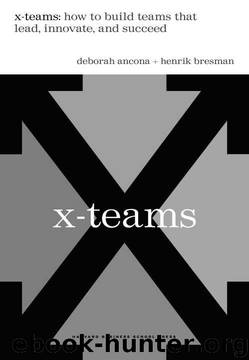X-Teams: How To Build Teams That Lead, Innovate, And Succeed by Deborah Ancona;Henrik Bresman

Author:Deborah Ancona;Henrik Bresman
Language: eng
Format: mobi
Published: 2008-06-16T18:13:00+00:00
Exploration
A team of equity traders from Merrill Lynch with eight to ten years of experience at the firm was charged with designing a new product using cutting-edge ideas about financial risk as outlined by Professor Andrew Lo in an investments course taught at Merrill Lynch by MIT Sloan School of Management faculty.
Coached to take an X-team approach by one of us, team members began by "sensemaking" about their industry. (As we mentioned, sense making refers to trying to understand the situation that you are currently facing.) In 2004, financial services were going through tough times: margins were getting compressed, and the business was getting more automated, resulting in more and more cost cuts. In both equities (stocks) and debt (bonds), markets had become too efficient. If word got out that something good was going on at Coca-Cola or Citigroup, everyone joined the feeding frenzy, and there was no way to make a lot of money. This team determined that it wanted to find a place where the market was not so efficient-where there was not so much coverage on the street in terms of research and information.
With this goal in mind, the team went into intense scouting and ambassadorial activity, looking for ideas and buy-in. But team members were not too sure how to go about this. Most of the team members were used to working at their own jobs, making their targets. They were not used to thinking more broadly or reaching out to people they did not know to brainstorm new product ideas. So team members were a bit unclear about what steps to follow.
But deadlines for reporting on progress were approaching, and so one team member, Adam Williams, stepped up to the task of organizing the members to engage in exploration, saying that the team had to divide and conquer and had to get some things done. He decided that someone would have to interview customers about their interests, someone else was needed to look at research, and someone else had to explore technology and compliance issues. Others at Merrill Lynch needed to be contacted so that team members could find interest, support, and ideas inside the company itself. With the tasks organized and spread out before them, team members volunteered for the things they wanted to do. Teammate Tara Shav declared that she had connections in technology and was also close to someone in compliance, so she could investigate whether the team's ideas were even feasible. Kristin Hill took on the task of organizing everything-from PowerPoint presentations to compiling all the data; she wrote everything down and pulled together many of the ideas. Thomas Roszko was to gather information at Merrill Lynch's New York headquarters.
Soon the team's queries brought in lots of ideas. The energy in the team heightened as members noted that people liked to talk to them and provide great ideas about what the product should be. Thomas Roszko (Tom) found pay dirt when he started talking to a senior desk analyst, Raj Sinha.
Download
This site does not store any files on its server. We only index and link to content provided by other sites. Please contact the content providers to delete copyright contents if any and email us, we'll remove relevant links or contents immediately.
Hit Refresh by Satya Nadella(9041)
The Compound Effect by Darren Hardy(8821)
Change Your Questions, Change Your Life by Marilee Adams(7640)
Nudge - Improving Decisions about Health, Wealth, and Happiness by Thaler Sunstein(7622)
The Black Swan by Nassim Nicholas Taleb(7016)
Deep Work by Cal Newport(6890)
Daring Greatly by Brene Brown(6451)
Rich Dad Poor Dad by Robert T. Kiyosaki(6414)
Principles: Life and Work by Ray Dalio(6227)
Playing to Win_ How Strategy Really Works by A.G. Lafley & Roger L. Martin(5939)
Man-made Catastrophes and Risk Information Concealment by Dmitry Chernov & Didier Sornette(5926)
Digital Minimalism by Cal Newport;(5669)
Big Magic: Creative Living Beyond Fear by Elizabeth Gilbert(5616)
The Myth of the Strong Leader by Archie Brown(5429)
The Slight Edge by Jeff Olson(5353)
Discipline Equals Freedom by Jocko Willink(5291)
The Motivation Myth by Jeff Haden(5158)
Stone's Rules by Roger Stone(5027)
The Laws of Human Nature by Robert Greene(5004)
